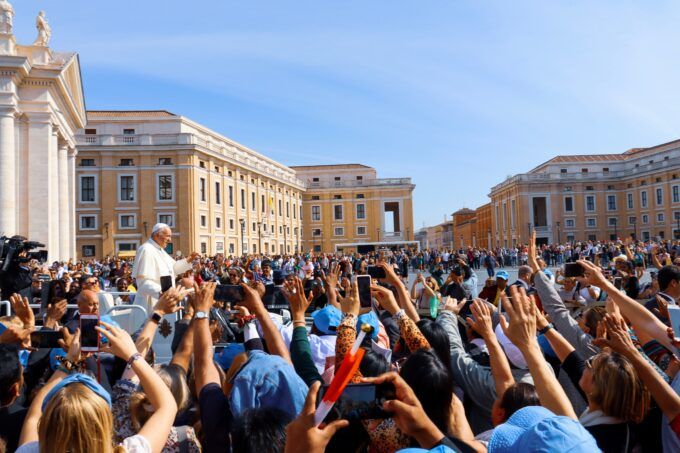
Image by Ágatha Depiné.
“I humbly beg forgiveness for the evil committed by so many Christians against the Indigenous Peoples.”
So said Pope Francis last week, at a powwow in Alberta, at the start of his “apology tour” across Canada — for the participation of the Catholic Church in the multi-century horror of Native American “residential schools” on this continent, which more accurately might be called concentration camps for 6-year-olds.
This papal mega-apology, while cheered by some, has been widely criticized as little more than a wimpy shoulder-shrug — sorry about that — for a governmental, church-complicit policy, lasting well into the 20th century, of snatching indigenous children from their families and squeezing their culture, if not their life, out of them.
Clearly an official apology is hardly adequate for this egregious wrong — one facet of the larger goal of genocide and continent-theft — but it does throw some raw, horrifying light on who “we” are . . . on the moral values of white, European, a.k.a., colonial, culture, which continues to hold enormous global power. Could the pope’s apology be the starting point of actual learning, troubling awareness and, good God, real change?
What has to happen first, of course, is taking a look at the reality in question. The phenomenon of residential schools, which permeated both the United States and Canada, may have had their origins in the early missions the white, Christian conquerors began building in the 18th century, the point of which was to eradicate indigenous culture and convert pagans to the true religion (and, oh yeah, grab their land).
By the mid-19th century, residential schools had become law in the U.S. Indigenous children were taken from their families without permission and, in essence, rebirthed as white people. The schools’ premise was infamously summed up in the words of Captain Richard Henry Pratt, headmaster of the Carlisle School in Pennsylvania:
“A great general has said that the only good Indian is a dead one. In a sense, I agree with the sentiment, but only in this: that all the Indian there is in the race should be dead. Kill the Indian in him, and save the man.”
This was not a platitude, the evil opposite of “love thy neighbor.” This mandate was taken seriously. The Indigenous Foundation points out some examples of the raw inhumanity to which the children were subjected, For instance:
“Attendance to the boarding schools was made mandatory by the U.S. government regardless of whether or not Indigenous families gave their consent. Upon arrival, Native children were given Anglo-American names, bathed in kerosene, given military-style clothing in exchange for their traditional clothing, and their hair would be shaved off for the boys and cut into short bob styles for girls.”
Let me repeat: bathed in kerosene! An awareness of the monstrous inhumanity being deployed suddenly goes straight up my nostrils.
And there’s more, of course:
“Native students were not allowed to speak in their Native languages. They were only allowed to speak English regardless of their fluency and would face punishment if they didn’t. The discipline enforced at these boarding schools was severe. . . . Additionally, Native students were neglected and faced many forms of abuse including physical, sexual, cultural, and spiritual. They were beaten, coerced into performing heavy labor. Their daily regimen consisted of several hours of marching and . . .
Fasten your seatbelts: “. . . recreational time consisted of watching disturbing movies such as Cowboys and Indians.”
And then there’s all those, uh, unmarked graves. The Indigenous Foundation points out that medical attention was scarce and infectious diseases sometimes ravaged a school and, guess what? Kids died. Lots of them died. And: “Parents were rarely informed of their children’s deaths.”
Just sit with that for a moment.
The dehumanization present here is virtually total. And it’s the work of government plus religion, opening up a question that, I fear, the pope did not address: Who are we that we could do this?
Can we begin answering this question? I can’t speak for Canada here, but the United States has spent most of its existence spiritually encaged by what I might call the “critical race theory mandate.” Don’t look at it, don’t talk about it, don’t acknowledge it. Don’t make yourself (or me) uncomfortable. But, OK, if you insist, sorry about that. Sorry for slavery as well. Sorry for the looming Armageddon.
As Politico noted, regarding the pope’s visit to Canada:
“many he came to comfort say he failed to offer a concrete way forward. Aside from a vague pledge to conduct a ‘serious investigation into the facts of what took place,’ many observers were left wondering what happens next. What concrete actions will the pope take to improve the lives of survivors?”
I would expand this question. Beyond reparations, what, oh God, can we learn? Can we sit in a circle with the wounded survivors and learn from them? It is, after all, the indigenous cultures of the planet that, among so much else, have begun bequeathing to the dominant culture such social sanities as Restorative Justice: turning our focus from punishment to healing, from separation to wholeness.
“All things are interrelated,” notes Rupert Ross at the end of his book, Returning to the Teachings (quoting from the book The Sacred Tree). “Everything in the universe is part of a single whole. Everything is connected in some way to everything else. It is therefore possible to understand something only if we can understand how it is connected to everything else.”
Can we learn this politically? Can we stop being conquerors? Can we surrender power to reverence?
This content originally appeared on CounterPunch.org and was authored by Robert Koehler.
Robert Koehler | Radio Free (2022-08-09T05:11:40+00:00) Surrendering Power to Reverence. Retrieved from https://www.radiofree.org/2022/08/09/surrendering-power-to-reverence/
Please log in to upload a file.
There are no updates yet.
Click the Upload button above to add an update.